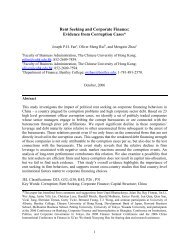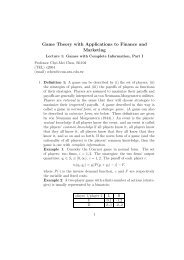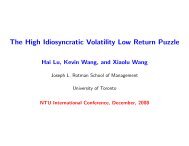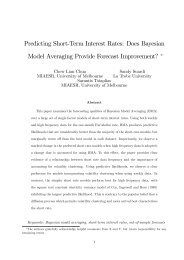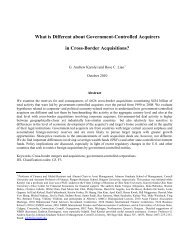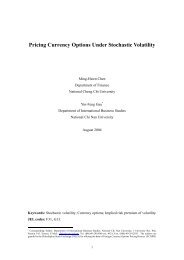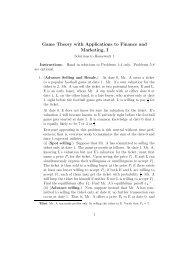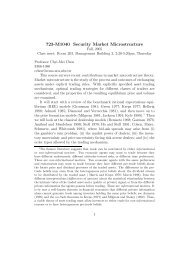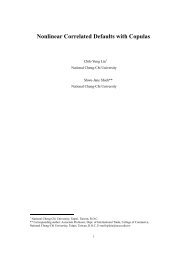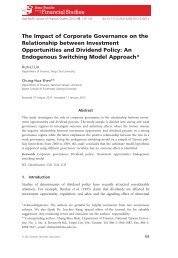Game Theory with Applications to Finance and Marketing
Game Theory with Applications to Finance and Marketing
Game Theory with Applications to Finance and Marketing
Create successful ePaper yourself
Turn your PDF publications into a flip-book with our unique Google optimized e-Paper software.
<strong>and</strong> given any ɛ ∈ R ++ , σ ∈ Σ 0 is called an ɛ-perfect equilibrium if<br />
∀i ∈ I, ∀s i , s ′ i ∈ S i,<br />
u i (s i , σ −i ) < u i (s ′ i , σ −i) ⇒ σ i (s i ) ≤ ɛ.<br />
A trembling-h<strong>and</strong> perfect equilibrium is then a profile σ ∈ Σ (which<br />
need not be <strong>to</strong>tally mixed!) such that there exists a sequence {ɛ k ; k ∈<br />
Z + } in R ++ <strong>and</strong> a sequence {σ k ; k ∈ Z + } in Σ 0 <strong>with</strong> (i) lim k→∞ ɛ k = 0;<br />
(ii) σ k is an ɛ k -perfect equilibrium for all k ∈ Z + ; <strong>and</strong> (iii) lim k→∞ σ i,k (s i ) =<br />
σ i (s i ), ∀i ∈ I, ∀s i ∈ S i . It can be shown that a trembling-h<strong>and</strong> perfect<br />
equilibrium must exist for a finite game, <strong>and</strong> the trembling-h<strong>and</strong> perfect<br />
equilibrium is itself an NE, but the reverse is not true. 1 In particular,<br />
the above profile (D,D) is not a trembling-h<strong>and</strong> perfect equilibrium.<br />
3. Consider the extensive game <strong>with</strong> two players where player 1 first<br />
chooses between L <strong>and</strong> R, <strong>and</strong> the game ends <strong>with</strong> payoff profile (2, 2)<br />
if R is chosen, but if instead L is chosen, then player 2 can choose<br />
between l <strong>and</strong> r, <strong>with</strong> the game ending <strong>with</strong> payoff profile (1, 0) if r is<br />
chosen, <strong>and</strong> if instead player 2 chooses l, then player 1 can choose between<br />
A <strong>and</strong> B, <strong>with</strong> the game ending <strong>with</strong> respectively payoff profiles<br />
(3, 1) <strong>and</strong> (0, −5). This game has a unique SPNE, (L,l,A), but (R,r,B)<br />
1 Let us prove that a trembling-h<strong>and</strong> perfect equilibrium σ is an NE. Recall the following<br />
definition of NE: a profile σ ∈ Σ is an NE if <strong>and</strong> only if for all i ∈ I, for all s i , s ′ i ∈ S i,<br />
u i (s i , σ −i ) < u i (s ′ i, σ −i ) ⇒ σ i (s i ) = 0.<br />
Note that for all i ∈ I, for all s i , s ′ i ∈ S i such that<br />
there exists K ∈ Z + such that<br />
u i (s i , σ −i ) < u i (s ′ i , σ −i)<br />
k ≥ K ⇒ u i (s i , σ k −i) < u i (s ′ i, σ k −i),<br />
by the fact that σ k → σ, <strong>and</strong> hence for any such k, we have<br />
implying that<br />
σ k i (s i) ≤ ɛ k ,<br />
0 ≤ σ i (s i ) = lim<br />
k→∞ σk i (s i ) ≤ lim<br />
k→∞ ɛ k = 0.<br />
This shows that a trembling-h<strong>and</strong> perfect equilibrium is an NE.<br />
2



